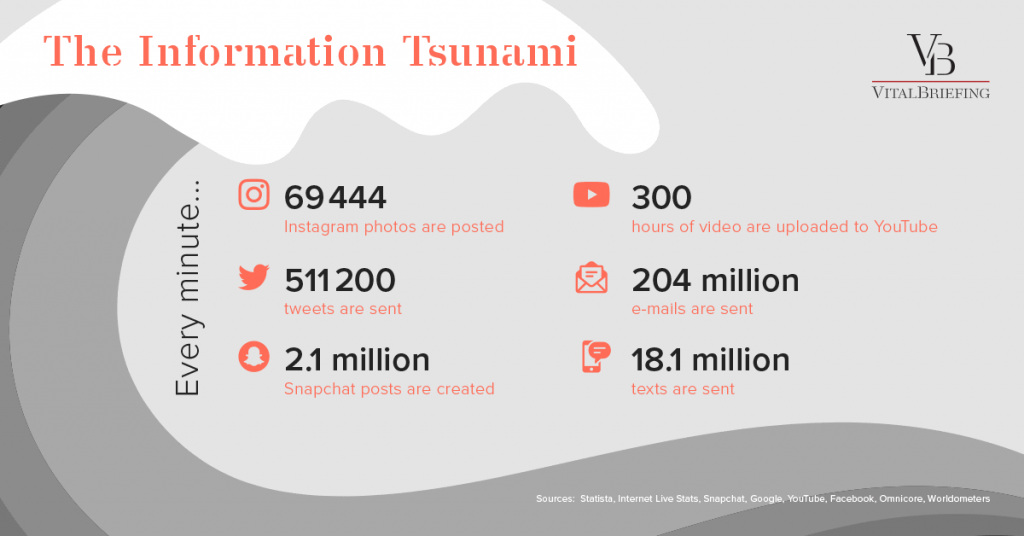Conducting business would be unimaginable without access to the internet, particularly for news and critical information.

Today, your favourite search engine delivers every catalogued article, review or social media posting in nanoseconds, rendering competitive intelligence and media monitoring easier than ever before.
Which begs the questions: which links should you trust?
The tsunami of articles, blogs, reports, studies and data – content – being published online is overwhelming. The Washington Post, for example, posts 500 articles every day; the New York Times, 230; the Wall Street Journal, 240; and BuzzFeed, 222.
And that’s from a few legitimate news sources. More than 2 billion blog posts were published — 5.76 million every day — in 2018 alone.
Knowing how to cut through all that noise efficiently and effectively to identify the most critical news and updates — the ‘news you can really use’ — is must-have. The current context, when disinformation, ‘fake news’, and political agendas are constant threats to fact-based reporting, the task is still more complicated by the need to identify and assess the sources you can trust.
Bottom line: effective media monitoring has never been more difficult. There is too much industry-related information for many companies to sift through.
Not new, just bigger
Information overload is not a new concept.
According to the Harvard Business Review, it’s been an issue for at least 2,300 years. There’s even a reference in the Bible to the growing menace of the printed word.
In the digital era, research shows that information overload is bad for business — and for your employees. When unfiltered, business and competitive intelligence are at best ineffective, at worst harmful.
From sales data to media reports, the value of that information declines sharply when recipients aren’t guided to what matters most. Information overload – a.k.a “infobesity” and “infoxication” – quickly leads to infoxiety (information anxiety).
As business psychologist Tomas Chamorro-Premuzic argues, information and news filters may simply confirm our own biases based on what Big Tech knows about us already.
Too much information also inhibits our ability to digest and process information.
Gamechanger: media monitoring
Even so, media and competitor monitoring can’t be overlooked as a crucial element in decision-making.
That information is a key component of any business and competitive intelligence and analytics architecture. A well-designed system will follow the latest news about your specific subjects, competitors, products, legal and regulatory developments.
Sounds like common sense. Yet designing an effective monitoring system is hard.
Even conducting your own internet search will quickly swamp you.
VitalBriefing is hardly the world’s largest multinational (for the moment), but a quick Google search for us tosses out 5 370 results.
Try a bigger media outfit, like the BBC or New York Times, and the results run into the billions.
Online notification services such as Google Alerts are free and easy to create. Yet the results can prove frustrating: complaints have been growing since 2013 that alerts are more about driving traffic to specific websites than about delivering relevant news.
Free filtering tools are fairly basic. For example, no matter how carefully you tailor them, alerts set for the ECB — European Central Bank — are just as likely to deliver match results and player news from the England and Wales Cricket Board (also the ECB).
At best, Google Alerts is a back-up when all else fails.
Media monitoring quality matters
Bain & Company’s consultants call infobesity the enemy of good decisions.
They suggest taking a step back, reviewing exactly what you need from your data, focusing on the important elements and standardising the output – in an internal email, on an intranet or in a corporate knowledge management system, for example — making it easier to digest.
They also suggest that timing is everything. With big data ever more accessible, the tendency may be to deliver too much information, too often.
But perhaps the most significant insight from Bain & Company is on ‘quantity’ and ‘source’. Not every executive decision needs every single news article on a successful product launch or the impact of a new regulation.
If the views are fairly uniform, then one or at most two will do, especially if the second adds new information.
For ‘source’, read quality. Algorithms and artificial intelligence aren’t always best at discerning quality media. Their filters often are founded on momentum and traffic volumes.
In entertainment, ‘clickbait’ articles create tremendous amounts of traffic (and advertising revenue), so popularity could be said to equal success of sorts.
But in business, law and finance, the most insightful articles may be hosted on trade-news websites, government or agency sites or hidden behind subscription paywalls.
Then there’s fake news, particularly regarding politics and current affairs. In the 2016 US presidential election and the UK’s Brexit referendum, fake news often was published on new and virtually unknown websites, their reach amplified by social media retweets and “likes”.
The human touch
Fake news is no longer confined to politics.
It can strike businesses big and small, often with a real financial and reputational impact.
That’s why media and competitor monitoring, news curation, competitive intelligence, and high-value business intelligence continue to require a human element.
As Andrew Koek explains, “The expert doing the curation takes the time to meticulously review all sources and carefully determine which material is most relevant and valuable. Even when you’re using automated tools, you still need someone in place to identify what’s most important and then translate it into usable insights.”
At VitalBriefing, we’ve assembled a growing team of journalists around the world with expertise in their chosen fields, from financial services to logistics to sustainable development to the space industry and beyond. Their experience and knowledge of what’s important to your business — and what’s credible — is an invaluable resource.
Here’s an example of ROI: for one of our global clients, whose 63,000 employees get our daily competitor monitoring (after the CEO and his direct reports), we noted from Tagalog-language newspapers in the Philippines that a competitor was building a new manufacturing plant. With that information, our client’s specialists were able to reverse engineer the technology being developed and to answer the threat with their own products.
Software and automation just can’t substitute for the human expertise and insight into what you specifically need to know to protect – and grow – your business.
We’re betting that will be the case for a long time to come.

